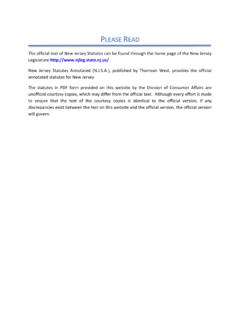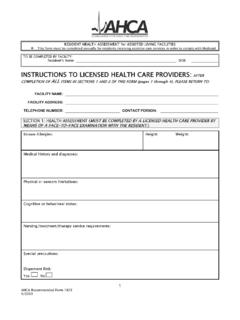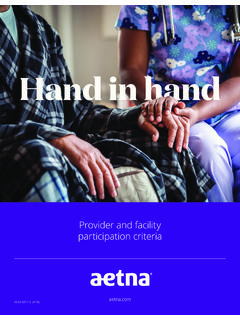Transcription of Standards of Practice for Professional Chaplains in …
1 Standards of Practice for Professional Chaplains in Hospice and Palliative care | 1 Standards of Practice for Professional Chaplains in Hospice and Palliative care OVERVIEW Preamble: Chaplaincy care is grounded in initiating, developing, and deepening a mutual and empathic relationship with patients, families and staff. The development of genuine relationships is at the core of chaplaincy care and underpins, even enables, all dimensions of chaplaincy care . It is assumed that all of these Standards of Practice are addressed within the context of such relationships. While the fields of hospice and palliative care differ, it is recognized that both specialties of care are on a continuum that is complementary and collaborative. These Standards incorporate both the distinctions and the similarities of chaplaincy care within each specialty.
2 Section 1: Chaplaincy care with Patients and Families Standard 1, Assessment: The chaplain gathers and evaluates relevant data pertinent to the patient s situation and/or bio-psycho-social-spiritual/religious health. Standard 2, Delivery of care : The chaplain develops and implements a plan of care to promote patient well-being and continuity of care . Standard 3, Access to Information and Documentation of care : The chaplain , as member of the interdisciplinary team, assesses and enters information pertinent to the patient s medical record that is relevant to the patient s medical, psycho-social and spiritual/religious goals of care . Standard 4, Teamwork and Collaboration: Team is an essential component of both hospice and palliative care , and the chaplain is a fully integrated member of the interdisciplinary team.
3 Standard 5, Ethical Practice : The chaplain will adhere to the Common Code of Ethics, which guides decision making and Professional behavior. Standard 6, Confidentiality: The chaplain respects the confidentiality of information from all sources, including the patient/family members, medical record, interdisciplinary team members, larger health care team and local faith community members, in accordance with federal and state laws, regulations, and rules. Standard 7, Respect for Diversity: The chaplain models and collaborates with the organization and its interdisciplinary team in respecting and providing culturally, psycho-socially and spiritual/religiously competent patient- and family-centered care . Section 2: Chaplaincy care for Staff and Organization Standard 8, care for Staff: The chaplain provides timely and sensitive chaplaincy care to the organization s staff via individual and group interactions.
4 Standard 9, care for the Organization: The chaplain provides chaplaincy care to the organization in ways consonant with the organization s values and mission statement. For the purpose of this Standard of Practice , organization may refer to the hospital where palliative care is based, the hospital that serves as the base for the hospice or the freestanding hospice organization. Standard 10, chaplain as Leader: The chaplain provides leadership in the Professional Practice setting and the profession. Section 3: Maintaining Competent Chaplaincy care Standard 11, Continuous Quality Improvement: The chaplain seeks and creates opportunities to enhance the quality of chaplaincy Practice . Standard 12, Research: The chaplain practices evidence-based care , including ongoing evaluation of new practices , and, when appropriate, contributes to or conducts research.
5 Standard 13, Knowledge and Continuing Education: The chaplain takes responsibility for continued Professional development. The chaplain demonstrates a working knowledge of current theory and Practice . Glossary, page 17. June 3, 2014 Standards of Practice for Professional Chaplains in Hospice and Palliative care | 2 INTRODUCTION HISTORY From the beginning, people of faith have been instrumental in the establishment and development of the modern hospice and palliative care The first hospices are believed to have originated from the 11th century Catholic orders when the incurably ill were cared for in hospices dedicated to treatment by In the early 14th century, the order of the Knights Hospitaller of St. John of Jerusalem opened the first hospice in Rhodes to provide refuge for travelers, and care for the ill and The Daughters of Charity of Saint Vincent de Paul in France and the Women of the Calvary in New York, who opened the House of Calvary to care for poor women afflicted with cancer and similar diseases in 1899, continued this Practice in the modern Later, the Irish Sisters of Charity opened St Joseph s Hospice in London, England in In the 1950s Cicely Saunders, a devout Anglican nurse, and later social worker, physician and writer, began to develop many of the foundational principles of modern hospice care .
6 Prior to World War II, Cicely Saunders had studied humanities. After the war began, she trained as a nurse, where she was introduced to the world of the suffering and the dying. In letters written in that time of her life, she spoke of patients having to earn their morphine, and often dying painful and lonely Her faith and the words of Psalm 37, Commit thy way unto the Lord; trust also in him; and he shall bring it to pass, fueled her commitment to provide better care for the sick and the Cicely Saunders nursing career was cut short due to a back injury, and out of a desire to continue in patient care , she trained as a social worker. In 1948, she met a young Jewish man from Warsaw, David Tasma, who was in the hospital dying of inoperable cancer. Saunders and Tasma spent much time together before he died.
7 Tasma s suffering became Saunders classroom. Tasma s spiritual, emotional and psychosocial pain became the foundation for Saunders revolutionary concept of total pain. 8 Together they explored the needs of dying patients and began to envision a better kind of care for the suffering and dying. During one visit recounted by Saunders, Tasma asked her for some words of comfort. Honoring his Jewish tradition, Saunders recited Psalm 23. Tasma asked if there was anything else she could say. When Saunders asked what else Tasma might want, he responded, I want what is in your mind and in your heart. This encounter became Saunders inspiration for St. Christopher s Hospice, which opened in 1967 and became one of the key centers of the modern hospice and palliative care movement. Based on what she had learned from Tasma and others, the St.
8 Christopher s Hospice vision was to provide whole-person care from the mind and the heart by addressing not just the physical, but also the spiritual, emotional, existential, psychological and social components of suffering. In the late 1960s, Cicely Saunders was also instrumental in the emerging field of medical ethics. She developed a Professional relationship and rapport with Rev. Edward Shotter, who set up the London Medical Group, a forerunner of the Society for the Study of Medical Ethics, and later the Institute of Medical Ethics. From 1966 to 1989, he was director of studies at the London Medical Group, and then he was appointed dean of Rochester, a post he held until retirement in Around this same time, a movement was growing in North America. In 1969, based on conversations with dying patients, Elizabeth Kubler-Ross published her groundbreaking book On Death and Dying: What the Dying Have to Teach Doctors, Nurses, Clergy and Their Own Families.
9 In 1971, the first coordinated hospice program in the United States was initiated by the Rev. Edward Dobihal, also the first chaplain to Grace New Haven Hospital (now Yale New Haven Hospital).10 He gathered a team of like-minded people and founded Hospice Inc., which was the beginning of a relationship with Florence Wald, Dean of the Yale School of ,12 Working with physicians from Yale s medical school, they established both a home- care program and a freestanding hospice facility (now named Connecticut Hospice) in Branford, CT in In 1975, Balfour Mount first coined the term palliative care 1 Aronson, Stanley M., The Early Years of Hospice care in Rhode Island. Medicine and Health Rhode Island, 2005, 88(4) . p. 108. 2 Connor, Stephen R.
10 , Hospice: Practice , Pitfalls, and Promise. Taylor & Francis. 2005, p. 4. 3 Connor, p. 5. 4 , cited June 5, 2013. 5 Connor, p. 5. 6 Saunders, Cicely and Clark, David, Cicely Saunders: Selected Writings 1958-2004, Oxford: Oxford University Press, 2006, 7 , accessed June 5, 2013. 8 Kearney, Michael, A Place of Healing, Louisiana: Spring Journal, 2009, 9 Reynolds, , and Tansey, eds., Medical Ethics Education in Britain, 1963-1993, London: UK: Wellcome Trust Centre for the History of Medicine at UCL, 2007, p. 8, 77, 118. Available from: 10 Connor, 11 Aronson, Standards of Practice for Professional Chaplains in Hospice and Palliative care | 3 to describe the inpatient hospital unit in The Royal Victoria Hospital in Montreal, Canada. Kubler-Ross, Mount, Dobihal12 and Wald were all influenced and inspired by Cicely Saunders and St.












